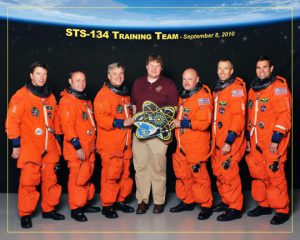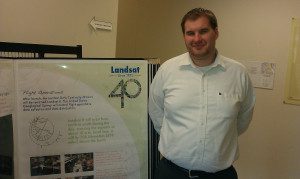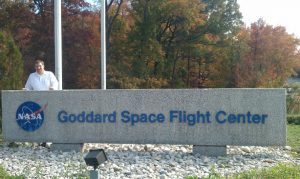
November 20, 2012
By Shari Kiple
Soon after graduating from Winona State, Brian From ’07 landed a job at NASA working with simulators and training flight controllers for the Space Shuttle program. Today, he works at Goddard Space Flight Center training satellite controllers for its next Landsat satellite, which is scheduled to launch Feb. 11, 2013.
Looking Skyward
From has lived many places (two dozen at last count) but spent much of his childhood in the Twin Cities area.
“Because I moved around so much growing up, it prepared me to go where my dreams would take me,” he says, “and I wanted my dreams to take me to NASA.”
After completing general education classes at a technical college, From transferred to Winona State. It was a single decision with an exponential impact.
Flight Training
“I always knew I wanted to study physics,” says From, who also minored in mathematics, “but I didn’t want a school with gigantic classes.”
With upper-level classes averaging only ten students, Winona State was the perfect fit. “I was challenged more within small classes, and I’ve been competitive with students from larger programs, but I wasn’t a face in the crowd,” he shares. “That was important to me.”
Systems Check
While taking a full class load, From also tutored for numerous Winona State courses in chemistry, physics, and math. This experience made his resume stand out.
“When a place like NASA hires people to do technical training, it’s not enough to have a physics or engineering degree,” he explains. “NASA is looking for teaching experience.”
Thankfully, he had tutored for three different departments.
“One of my favorite jobs was through Winona State’s general walk-in program, so I was tutoring for math, physics, and chemistry all at the same time,” says From. “It often involved working on the fly because I never knew what might happen next.”
“As hectic as it sounds to be jumping all over the place and teaching people to solve their problems, I loved it,” he shares. “I couldn’t do it for them, but I had to coach them to figure it out for themselves. That helped me immensely for my career at NASA.”
Career Countdown
 Personal attention from Winona State’s professors also shaped From’s career. “I give so much credit to my Winona State professors for teaching me the skills I have today,” he says.
Personal attention from Winona State’s professors also shaped From’s career. “I give so much credit to my Winona State professors for teaching me the skills I have today,” he says.
His number one influence? Nathan Moore, professor of physics. “He wanted to push each one of us, but I’d never had expectations like that before,” shares Brian. “He challenged the heck out of me, and the first grade I earned from him was only a ‘C,’ but it was the hardest earned grade I ever received. More than anything, he taught me to never back down.”
By his senior year, he was earning straight As and received the Physics Department’s nomination for WSU’s School of Science & Engineering Award, which was perhaps as meaningful as his graduation diploma.
Liftoff
From’s first employer found him through an online source, urging him to apply as an instructor for NASA’s Space Shuttle program in Houston. Following a “gauntlet of interviews,” From was offered his first dream job as a Shuttle communications training instructor, expertly prepared as a network simulations specialist (or SIMNET, as it’s known at NASA). His main responsibility: training flight controllers and personnel in the NASA communications network.
“When I got to Houston, I was surrounded by people who had dreamed their whole lives of working for NASA, just as I had,” he says. Following extensive training, which he completed in record time, From was prepared to train flight controllers for the space shuttle missions, a job he held until early 2011 when only two Shuttle missions remained.
For Brian From, his Winona State experience began a ripple effect that’s reaching outer space.
For Brian From, his Winona State experience began a ripple effect that’s reaching outer space.
Re-Entry
With just seven months remaining in the Shuttle program, From realized his time in Houston could be winding down. “I knew I couldn’t do that forever,” recalls From. “I knew I wanted to stay at NASA.” He was soon moved to the International Space Station program, where his new job involved working with astronaut crews to manage logistics, including food, oxygen, fuel, and waste.
“Every few months the crew would come down and a new one would go up,” he explains, “so one of the highlights for me was educating the new crew on what to expect.”
Since this role involved only limited training, From knew he wanted to do more. “My personal calling is education. Teaching people,” he says. “I wanted to do what I loved.”
New Mission
After receiving a lead from a former co-worker, From applied for an opportunity that would once again involve training, this time for satellite controllers at NASA’s Goddard Space Flight Center. The fit was ideal, and the job was his.
As simulation director, From now trains controllers for the Landsat 8 satellite, which is scheduled to launch February 11, 2013. The satellite, in its first launch since 1999, will orbit 438 miles above the Earth’s surface in the thinnest part of the atmosphere. From says that Landsat 8 will be the first satellite using a quantam well infrared photodetector, which will be used to create a thermal image of the planet.
“It’s definitely crunch time. We’re doing our ‘full up’ training simulations, but instead of data coming from the real thing, it’s coming from a simulator,” he says. “We’re doing everything we can to prepare satellite controllers so they know how to function, what to expect, where to turn if there’s a problem.”
Inspiring Tradition
Since 1972, the Landsat program has involved a series of Earth-observing satellite missions jointly managed by Goddard and the U.S. Geological Survey. As NASA’s longest running satellite program, it is the source for many of the earliest (as well as the most current) images of what Earth looks like.
“Landsat satellites have been going up for 40 years,” notes From. “It’s an incredible tradition.” And that tradition is part of what drew him to NASA when he was just a child.
“To me,” he says, “one of the greatest things about the U.S. space program is the overall benefit to all of mankind. NASA does things purely for understanding our world and everything about it.”
“It gets to the core of knowledge for the intrinsic value of learning and knowing. It inspires people to dream of doing the kind of work that I do.”
Read more about the Goddard Space Flight Center and From’s work: www.nasa.gov/centers/goddard


